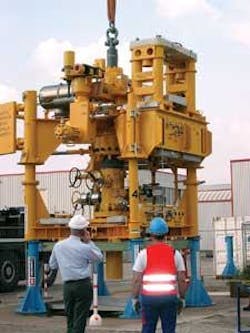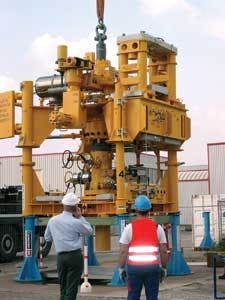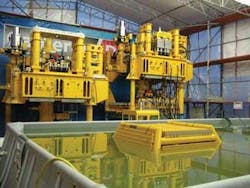All-electric subsea controls strengthen security of K5 operations
Jeremy Beckman - Editor, Europe
Gas production is under way at the K5F field in the Dutch North Sea, by means of the world’s first all-electrical subsea production system. Operator Total E&P Nederland developed the technology with Cameron to overcome weaknesses in conventional, hydraulically activated systems.
K5F is in block K5 in the Dutch sector, in 40 m (131 ft) of water, around 110 km (68 mi) northwest of the port of Den Helder. The field was discovered in 1999 and has estimated recoverable reserves of 3.3 GN cu m (3.3 billion normalized cu m) of gas and 0.9 MMbbl of condensate. Total’s partners in the project are Energie Beheer Nederland, Dyas, and Lundin Netherlands.
Production started in September via two wells, initially at 1.2 MN cu m/d (1.2 million normalized cu m/d), ramping up gradually to a peak of 2.5 MN cu m/d (2.5 million normalized cu m/d) early in 2009. The jackupEnsco 72 installed the wells and the associated subsea trees this spring.
Gas is exported to the K6N satellite platform via a 10-km (6.2-mi) long, 8-in. (20.3-cm) diameter flowline. The gas treatment facilities on the platform have been modified with respect to gas inlet and water treatment to process supplies from K5F for onward delivery to Den Helder through the Noordgas Transport trunkline. All the gas has been contracted to Gasterra, the largest midstream trader in the Netherlands.
Total awarded Subsea 7 the contract for engineering, procurement, construction, and installation of the flowline and umbilical systems and associated tie-in and pull-in operations. The scope also included supply and installation of the subsea protection frame/template, complete with pipeline end manifold and integrated umbilical distribution equipment.
Isleburn fabricated the 160-metric ton (176-ton) protection structure at its yard in Nigg, northern Scotland, and it was installed in February 2007 by the DSVToisa Polaris, operated by Subsea 7. The protection frame also provides capacity for a third well on K5F that will likely be drilled in 2010, and tie in of an optional fourth well planned nearby on a separate gas accumulation. Control of the wells and valves for chemical injection is provided by an 18-km (11-mi) umbilical connecting the manifold with Total’s K6P/C gas treatment facility.
Low maintenance challenge
The basic function of the CameronDC all-electric subsea trees on K5F is similar to that of standard topsides platform christmas trees. They incorporate a series of valves that allow the wells to be operated and to shut in safely during installation, production, and workovers.
Sensors installed at various locations in the assembly measure temperature and pressure of the gas, with further provision to monitor pressures in the annuli. Chemical dosing is regulated using the injection valves, which helps to prevent corrosion and formation of hydrates in the flowline. Both trees also are equipped with a choke valve to regulate gas flow.
Cameron has designed the trees for maintenance-free operation during their entire service lives. The main challenges in meeting these requirements included selection of materials, the corrosion protection system, and components with a high degree of reliability. The system also had to be designed to minimize diver interventions during installation.
Unlike conventional subsea production systems, K5F’s christmas tree valves operate by electric actuators powered by direct current. Total was concerned that hydraulic systems have been susceptible to leaks. It also said that hydraulic control modules were a weak link in subsea production systems because they are only partially redundant.
In contrast, the Cameron electrical system is fully redundant right down to the system’s final elements (the valves). And all sensors on the christmas trees are redundant and fully isolated from each other to improve availability of the production system. There are no batteries or accumulators, and much of the conventional electro-hydraulic equipment items have either been eliminated or simplified.
The electrical configuration also overcomes the limitations of a hydraulic system in terms of transmission distances and response time – commands can be relayed in seconds to avoid the lag time need for accumulator charging. It also has environmental benefits because there is no hydraulic fluids disposal.
Electricity distribution is provided by 3,000 V DC supply modules installed on the K6P gas treatment platform. The communication signals needed to control the christmas trees are superimposed onto the high-voltage power by means of four coaxial cables in the umbilical, connected to four subsea power regulation and control modules (PRCMs).
At K5F on the seafloor, a PRCM receives the communication signals and power feed, and transforms the high voltage required to bridge the long distance down to the lower operating voltage (300 V) of the subsea production system.
Each PRCM links to an electric subsea control module (ESCM), which controls the electric actuators and receives signals from the various sensors on each tree. Both trees have two ESCMs that can assume full operational control from each other without the need to interrupt production.
In order to reduce the umbilical’s size and complexity, seawater is the conductor for the return current (i.e. the “ground” of the electrical system). This is done by installing a cathode on the K5F subsea protection frame and an anode on one side of the K6P platform. Both cathode and anode are connected via seawater conduction. Underwater connections between the umbilical and the subsea equipment are effected through a series of high voltage connectors on the umbilical termination assembly.
One critical component in the all-electric system was Cameron’s development of the fail-safe electric actuator, which comprises a drive motor and a clutch motor. The drive motor forces the valve open against the closing spring. When the valve is fully open, the clutch motor ensures it remains open through use of a friction-based mechanism.
In the open position, the drive motor is at zero load. Little power is needed from the clutch motor to sustain the valve open. Should the electrical supply be interrupted, the closing spring ensures that the valve is returned to the safe-close position.
According to a recent presentation at a subsea conference in London by Roland Festor, managing director of Total E&P UK, the all-electric trees have performed well since production started on K5F. There have been (unrelated) difficulties with hydraulically driven downhole safety valves, he said, but Total was working to solve the problem by converting these to electrically operated devices also.
Cameron says its technology would be suited to developments in greater water depths, and could also be applied to ultra long distance step-outs, beyond 100 mi (161 km). The company also says that by eliminating the need to transmit hydraulic signals through the umbilical, communication with seabed equipment becomes virtually instantaneous, likewise feedback on conditions subsea.




